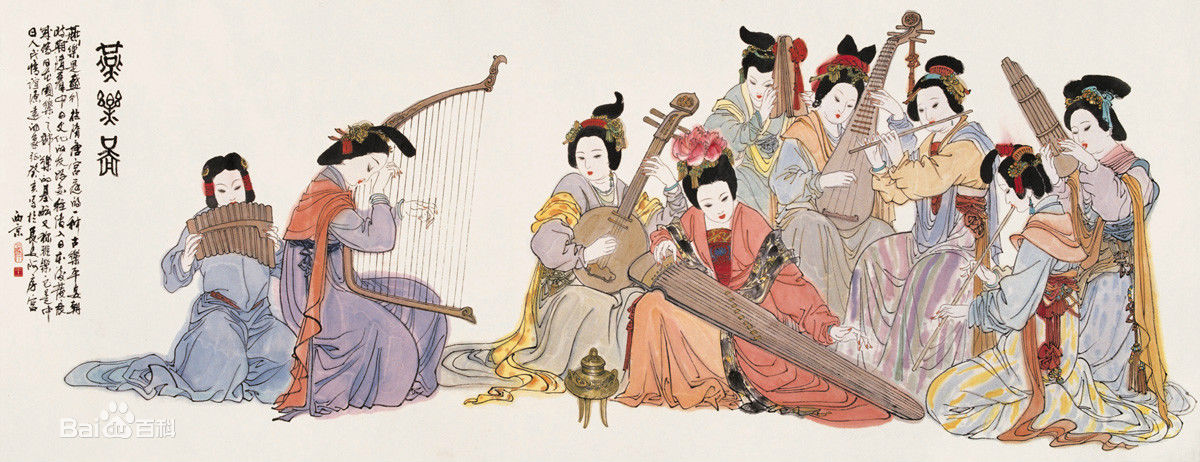Explore kinship of ancient music, literature

The ci-poetry is a typical kind of musical literature. Its creation and circulation are directly related to music. The music that ci-poetry cooperates with is called Yanyue, or court banquet music, a song and dance music that provided entertainment and appreciation during the court banquet of the Sui, Tang and the Song dynasties.
Ancient Chinese musical literature has existed for around 4,000 years, but is has only been subject to modern research for the last century. “From the Book of Songs and The Song of Chu, to the lyric poetry, narrative literature that flourished in the Tang Dynasty, ci-poetry, poetic drama set to music, the scriptures of folk religions, and folk operas... A history of Chinese musical literature is not only a product of the survival and development of Chinese civilization, but also a result of cultural exchanges between Chinese culture and the surrounding ethnic cultures. Chinese musical literature is not only one of the core aspects of aristocratic ceremonial culture but also an important form of folk culture,” said Sichuan University professor Sun Shangyong, the chief expert behind the National Social Science fund of China’s “General History of Ancient Chinese Music Literature” project.
The study of modern Chinese musical literature was led by Wang Guowei’s works, such as Daqu of Tang and Song Dynasties and Song and Yuan Opera History. In the 1920s, Zhu Qianzhi and other scholars first proposed the concept of music literary history. In the last century, the academic world has achieved fruitful results, but there is still much to be researched.
Sun and scholars from Sichuan University, Jinggangshan University, Northwest University and the Sichuan Conservatory of Music formed a research team and strived to develop relevant literary materials in a broader field and make full use of the research results of Chinese literature, musicology, music archeology and music morphology. They aim to emphasize the long-term trajector of music literature, find the internal logic and external laws of different types of music literature throughout history, use new analytical methods instead of the old narrative techniques to organize materials, and accomplish the first integrated General History of Ancient Chinese Music Literature.
Zhu Wanshu, a professor from Renmin University of China, said the general history of Chinese music literature must be grounded in basic academic logic and philosophy. Every stage of music literature has a close relationship with other stages, so we must pay attention to this consistent internal connection to demonstrate a sense of cohesiveness.
At the opening report meeting of General History of Chinese Ancient Musical Literature and the symposium on Chinese ancient musical literature held in mid-May, Sun said that the value of their work is mainly reflected in three aspects. The first is to meet the needs of academic development and provide a general summary of the history of Chinese musical literature. The second is to perfect the disciplinary structure of musical literature and solve related theoretical problems, including debate over the attributes, meanings and scope of Chinese music literature on a theoretical level, and to provide an in-depth and reasonable explanation of some basic theoretical issues of Chinese music literature, as well as exploring the relationship and evolution between language and music. The third is to integrate different research orientations, which is expected to form a number of major breakthroughs in Chinese classical academic research.
Zheng Acai, a professor from Sichuan University, said that a general history of Chinese musical literature could combine music with literature, removing the divided approach of literary and music history in the past, and pay attention to the combination of “sound and emotion” and “literature” in an effort to achieve a comprehensive system, which is a very difficult but important academic task. Zheng added that Buddhist Songs and Tao songs can be included in this research category to complete the system. Some works of popular literature, such as folk songs and popular tunes, can be added to related studies on popular literature.
Luo Yifeng, a professor from the Xi’an Conservatory of Music, said that establishing an appropriate historical view of musical literature is the basis of all this work. That is, we must open our horizons and adopt cross-cultural, cross-language, and cross-domain approaches. Qian Zhixi, a professor from Peking University, emphasized the scope of music literature. In his view, almost all verses in ancient China, including operas, can be said to have evolved from music. Even if they are modern styles of poetry, they still have a musical basis. Literature and music are in some degree contradictory. When literature develops to a certain stage, it is and ha to detached from music. The peak of entire Chinese literature emerged after it was detached from music.
Zhou Xuanlong, deputy editor-in-chief of the People’s Literature Publishing House, pointed out that it is essential to avoid studying music literature from a single perspective, be it from literary or musical aspects. The two should both be taken into account. Scholars must link the internal force of literature with its history, and find the intersection of literature and music in this process to get rid of the unilateral constraints of musicology or literature.
(edited by SUI JINGJING)
